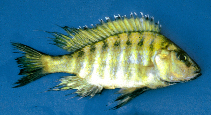| Family: |
Cichlidae (Cichlids), subfamily: Pseudocrenilabrinae |
| Max. size: |
15 cm TL (male/unsexed) |
| Environment: |
benthopelagic; freshwater; depth range 50 - 125 m |
| Distribution: |
Africa: endemic to Lake Malawi. Recorded from southern part of lake. |
| Diagnosis: |
Dorsal spines (total): 14-16; Dorsal soft rays (total): 9-11; Anal spines: 3-3; Anal soft rays: 8-10. Diagnosis: high number of gill-rakers; head length 31.7-35.6% of standard length; preanal length 58.7-63.1% of standard length; head width 42.2-45.4% head length; premaxillary pedicel length 22.3-25.9% head length (Ref. 55908).
Description: relatively deep-bodied; mental processus relatively small; pores in infraorbital series not remarkably enlarged; jaws isognathous; jaw teeth in outer series fine, elongate and mostly bicuspid, changing to unicuspid in the largest specimens; inner teeth of jaw unicuspid; cheek with 2-4 series of scales; pharyngeal jaw stout but not greatly enlarged, with enlarged to molariform teeth; gill-rakers normal to long and simple; 22-30 scales in upper part of lateral line, 11-18 in lower part; adults with elongated dorsal and anal fins with long streamers (Ref. 55908).
Coloration: Live: Adult territorial males: background color bronze, with relatively broad dark bars; most of head, and dorsal and dorso-lateral parts of body somewhat more yellowish-bronze; ventral body parts bronze with black pigment, becoming black in fully sexually active males; unpaired fins bronze; broad white margin and narrow dark submarginal band on dorsal fin; dorsal and caudal fins with yellow-green maculae and striae; pelvic fins dark; pectoral fins yellowish; anal fin with proximal part darkest, and large, white or yellow ocelli (Ref. 55908). Females: silvery with a yellow hue; fins yellow-grey; vague dark maculae and striae pattern on dorsal and caudal fins (Ref. 55908). Color pattern of immature and non-territorial males intermediate between the female and adult male pattern, becoming more bronzy and darker with increasing territoriality (Ref. 55908). Preserved: Juveniles, females and non-territorial males: brownish yellow with 7 dark vertical bars below dorsal fin; dorsal and caudal fins brownish yellow with dark maculae; pelvic and anal fins whitish yellow (Ref. 55908). Territorial males: brown with dark vertical bars; parts between bars light brown; branchiostegal membranes and ventral body parts dark brown; unpaired and pelvic fins dark grey to black; pectoral fins whitish; dorsal fin lappets white (Ref. 55908). |
| Biology: |
Occurs in areas with a bottom deposit of diatom ooze (Ref. 267). Probably feeds on diatoms (Ref. 5595). |
| IUCN Red List Status: |
Least Concern (LC); Date assessed: 22 June 2018 Ref. (130435)
|
| Threat to humans: |
harmless |
Source and more info: www.fishbase.org. For personal, classroom, and other internal use only. Not for publication.
